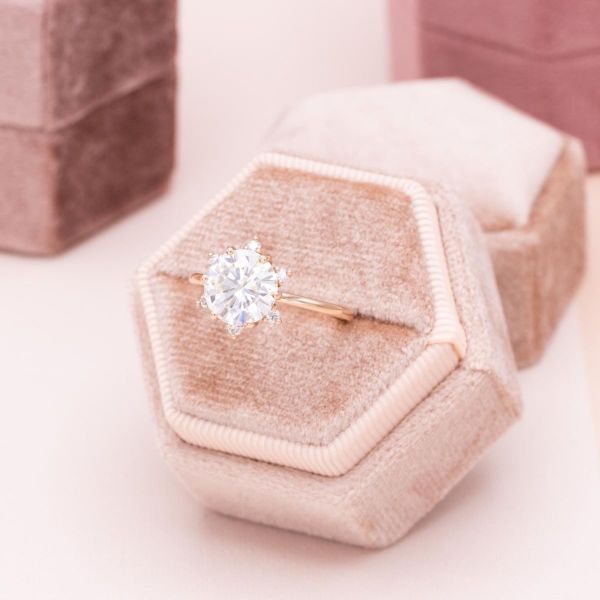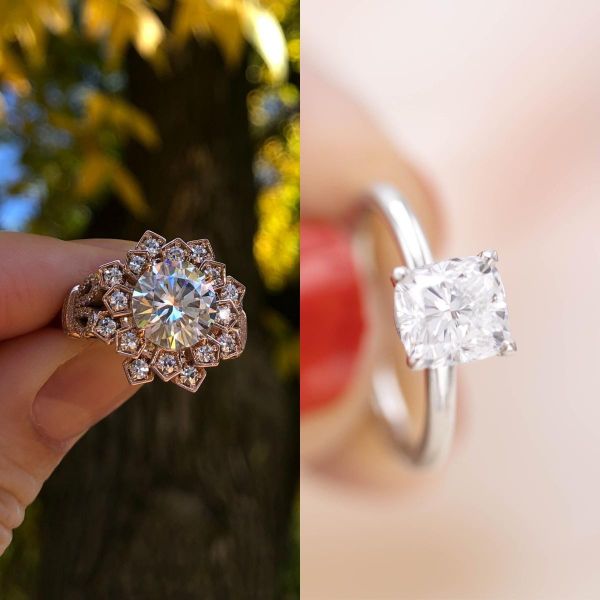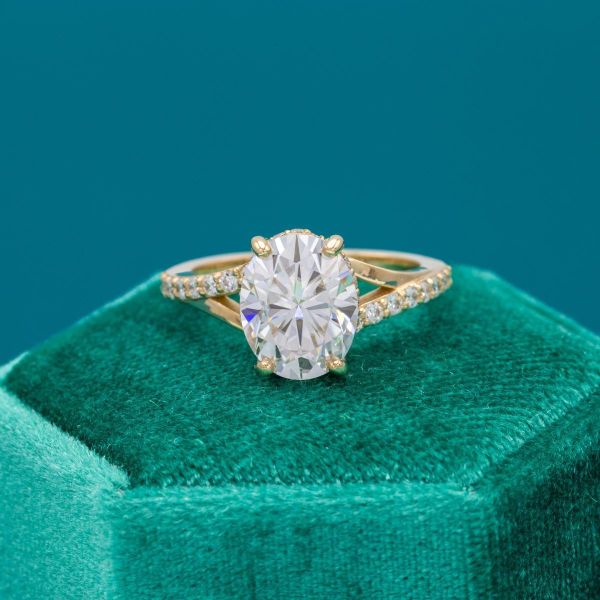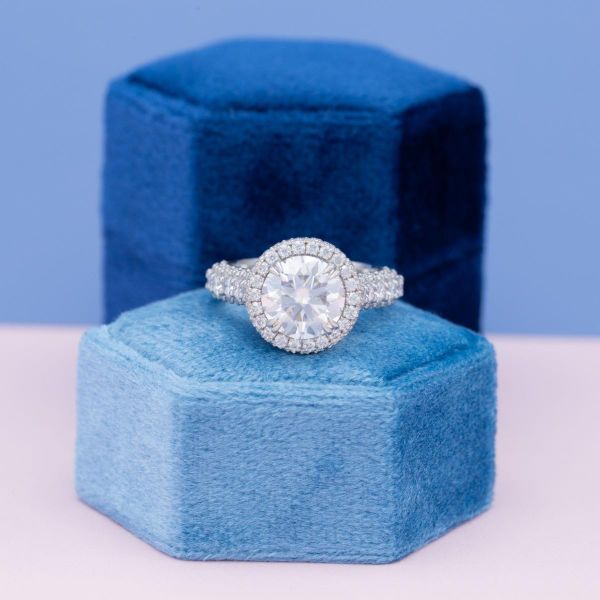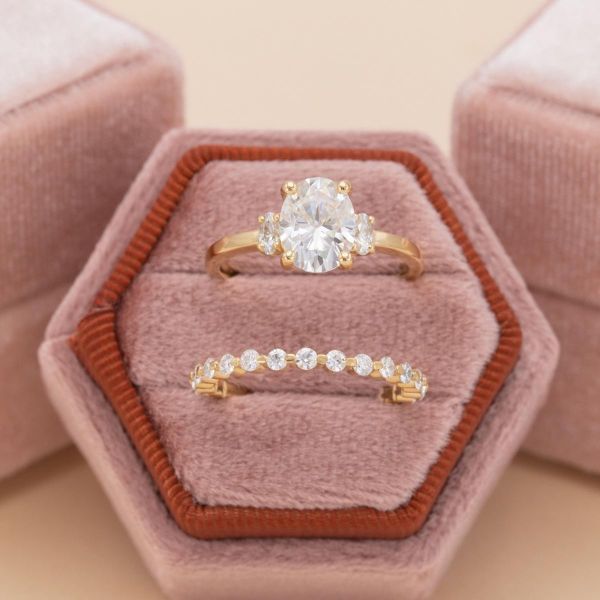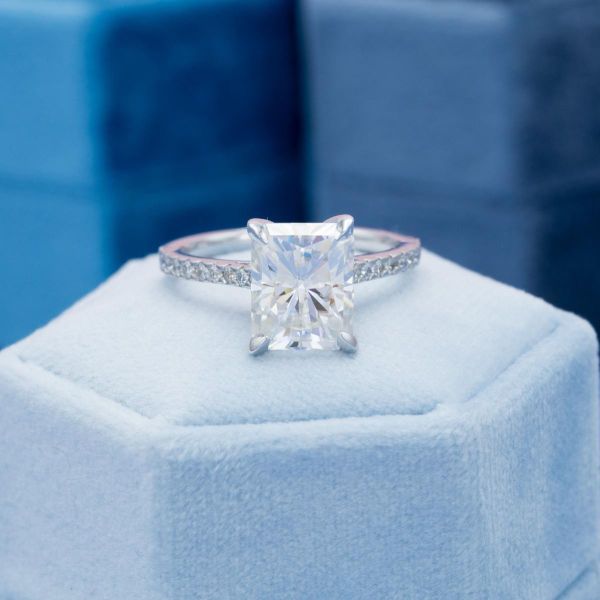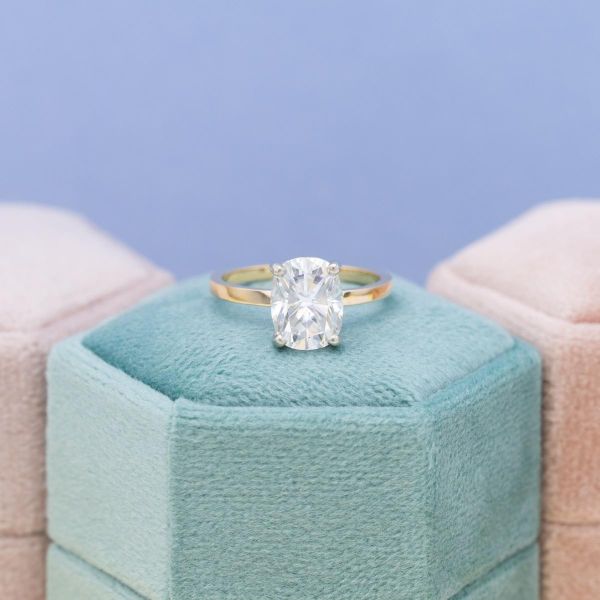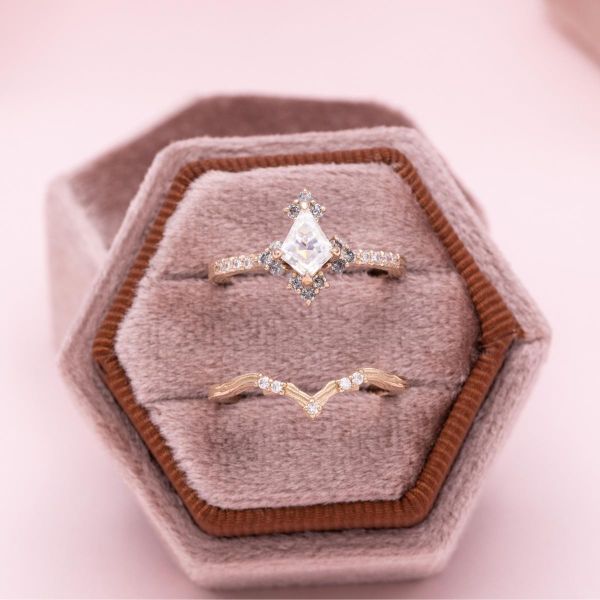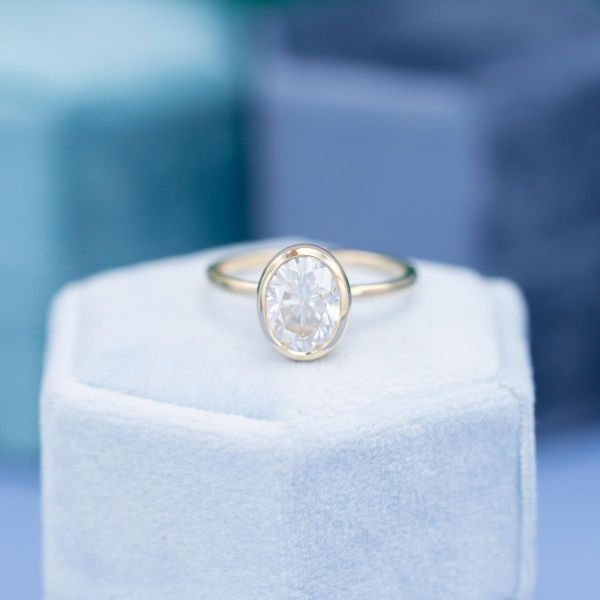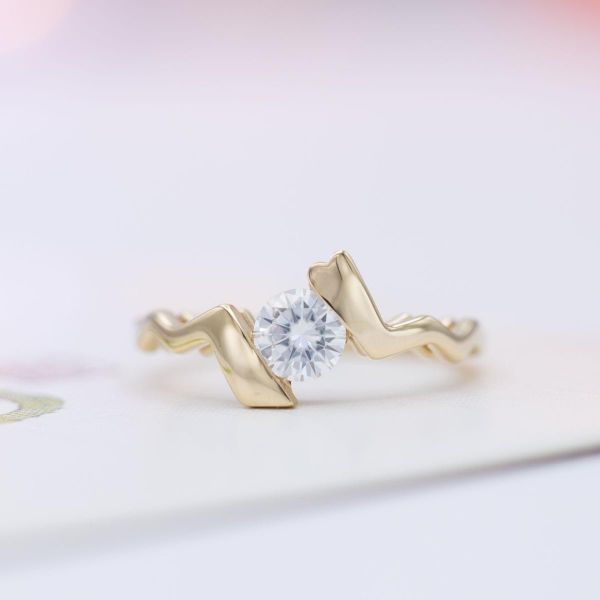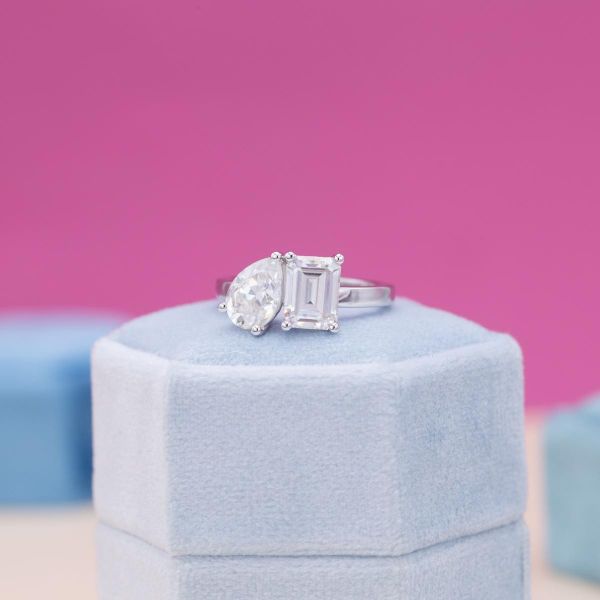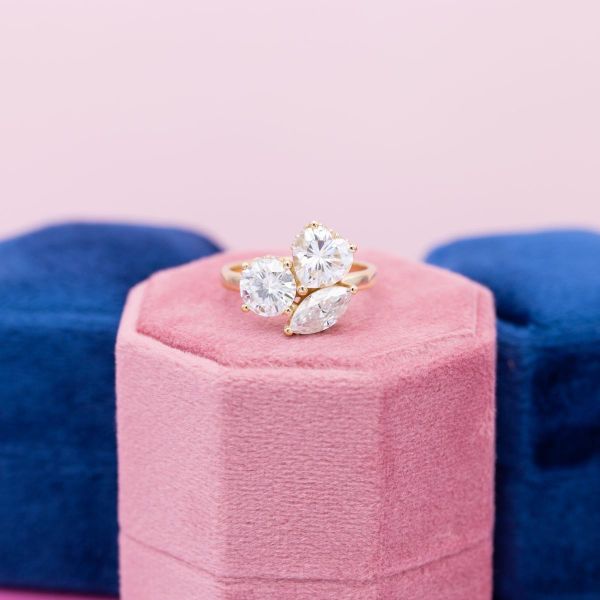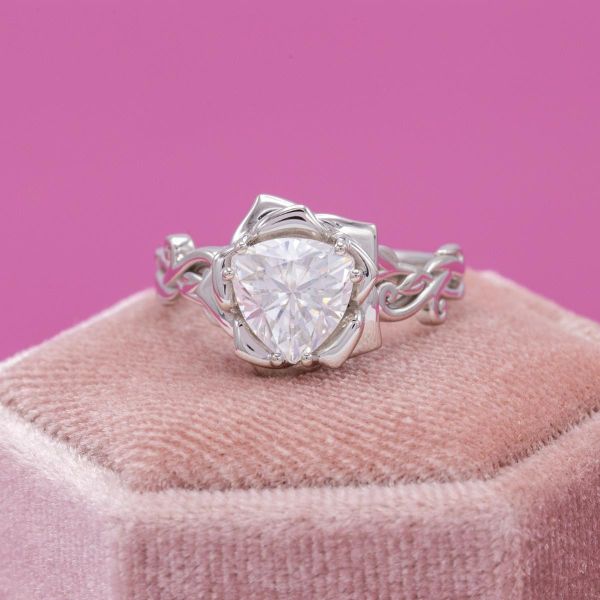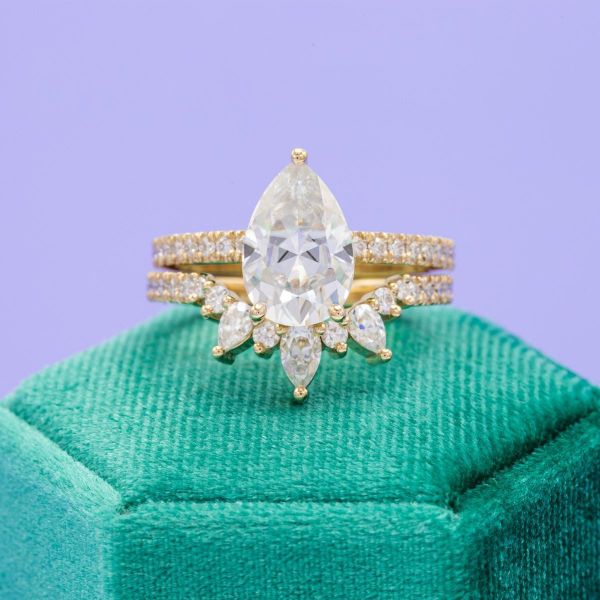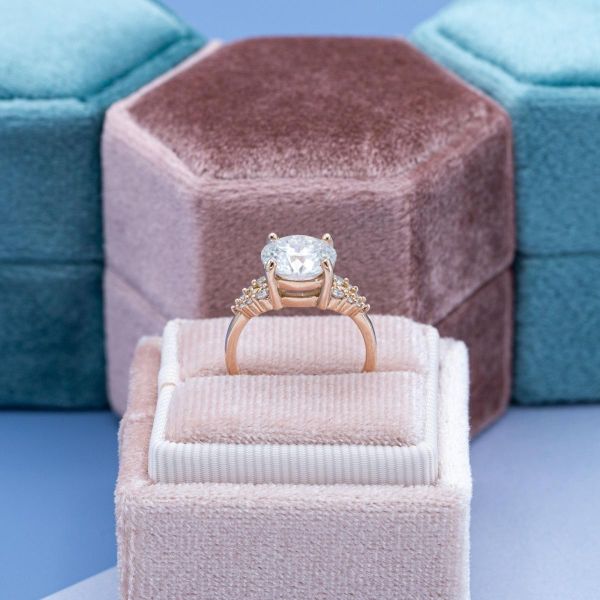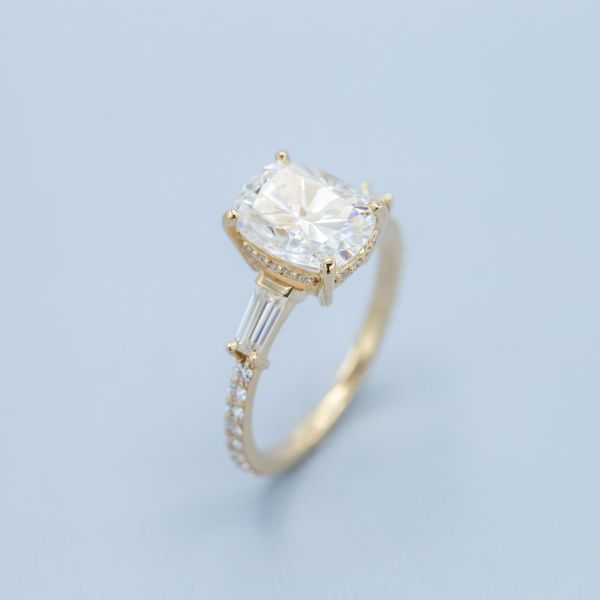Diamond alternatives
Is moissanite a good choice for an engagement ring?
Moissanite offers a great balance of quality and value for couples looking for a diamond alternative, but is it the right choice for your engagement ring?
Should you choose moissanite for your engagement ring?
You know what they say: diamonds are a girl’s best friend! But a lot has changed since Gentlemen Prefer Blondes hit the big screen in 1949, including engagement rings. We’ve seen some couples start to forgo the classic diamond ring for something different, whether it be a royal blue sapphire or twin flame toi et moi style.
Many couples still opt for the classic look of a diamond for their engagement ring but might not quite be sold on the stone. Maybe they’re questioning the ethics of a mined diamond, concerned about imperfections, or sweating over the hefty cost per carat. While we love diamonds, we totally get it and are here to help you pick whichever stone is right for you!
For couples seeking the diamond aesthetic without the name recognition or price, we recommend diamond alternatives. One of our favorite alternatives that has the diamond look, excellent hardness, colorful sparkle, and a reasonable price tag is moissanite.
While it was first discovered in 1893 at the site of a meteorite crash (seriously, how cool is that?!), moissanite used in jewelry today is always lab-created. Even though it originally fell from the stars, it’s much easier than a rover trip to Mars to get this stone for your engagement ring. Let’s take a look at the many reasons why moissanite is a great choice and how it stacks up to a diamond.
Reasons to choose moissanite
It has the colorless look of a diamond with rainbow sparkle
When it comes to white stones, moissanite really gives diamond a run for its money! The moissanite we use in our jewelry is colorless on the same grading scale used for diamonds, so you can be sure you’ll have a bright clear stone if you go with moissanite.
Where both moissanite and diamond offer up a colorless vibe, they vary a bit with the way they sparkle and shine. Both moissanite and diamond give off a sparkle of white light (also known as brilliance) and colored light (fire), but how much they each have is a little different.
Moissanite’s higher refractive index means it produces a bit more brilliance than a diamond. But where their sparkle differs most is in moissanite giving off notably more fire than a diamond. What does that mean for us non-science nerds? Moissanite is going to have a little more white sparkle than diamonds and a lot more rainbow sparkle.
Moissanite is a guilt-free, ethically sourced stone
When choosing their engagement ring stone, some couples have concerns about the ethics of a naturally mined diamond, as in the past there have been questions about working conditions and environmental impact. While things have improved greatly over the past years (a lot has changed since Gentlemen Prefer Blondes, remember?), some couples opt for a lab-created diamond to avoid any question of ethics. Others, though, have chosen to look outside of diamonds altogether for their colorless stones and found moissanite to be a great option for them.
Moissanite’s lab-created origin means they’re crafted by professionals in a controlled setting, so there’s no mining involved. No mining means no potential human rights violations or environmental impact, and lab-created stones actually produce less waste than mined. Moissanite lets you create the ring of your dreams knowing it is completely ethical!
It's durable and highly scratch resistant
Moissanite is as durable as it is lovely, which is great whether you’re as graceful as a swan or clumsy as a bull! Experts grade gemstones with the Mohs scale of hardness, which ranges from 0 (the most delicate) to 10 (the hardest). Moissanite checks in at an impressive 9.25 on this scale. This means that moissanite is one of the hardest substances found on earth, beating out sapphire and ruby–which both come in at 9.0 on the scale–and sitting just below diamond at a perfect 10!
This incredible durability means moissanite is very scratch resistant, which is ideal for daily wear like you’ll plan for your engagement ring. While you won't have to worry too much about scuffing your ring against a hard surface, you should still always be careful when wearing any piece of fine jewelry. If your ring includes other softer stones—like opal or pearl—you’ll have to be extra careful to avoid damaging these gemstones.
Always take the best care of your moissanite engagement ring! Remember to:
- Remove your ring when exercising, showering, cleaning, or doing any activity where you work with your hands.
- Avoid getting harsh chemicals — perfume, lotion, cleaning or lawn care products, etc. — on your ring.
- Clean your ring at home regularly. Give it a gentle scrub with dish soap, warm water, and a soft toothbrush monthly for best results.
There are plenty of shapes and cuts to choose from
Because it's lab-created, moissanite comes in every shape imaginable, and you can find popular round and oval versions as well as lesser selected shapes like hearts and triangles (also known as a trillion cut!). Moissanite comes in both brilliant and step-cut styles as well. That variety allows for different looks in the same silhouette like a radiant cut or emerald cut octagon.
Unlike diamonds—which sparkle the most in a round brilliant cut due to the way light travels through the stone—moissanite gives off a high level of brilliance and fire no matter what cut you choose. That means a step-cut moissanite will give you more sparkle than the same cut of a diamond.
It looks great in any setting
Because it has similar visual appeal to a diamond, moissanite looks dazzling in all setting styles. Moissanite’s neutral white color works well with any metal or accompanying colored gemstones, and it looks as great as an accent as it does at the center of your engagement ring. Plus, moissanite’s sparkle shines bright in both bezel and prong settings.
From solitaires to halos, Art Deco-inspired pieces to modern styles, moissanite can make any setting twinkle! Just look at some of the brilliant designs couples have come up with involving the prismatic sparkle of moissanite:
Moissanite vs. diamond: how do they compare?
So now that we’ve dug into moissanite as a diamond alternative, which stone is right for you? Let’s look at how diamonds and moissanites compare in three important categories: price, durability, and beauty.
Price
When it comes to budget friendliness, moissanite is the clear winner! A 1 carat mined diamond can reach prices of $7,000-$10,300, while a colorless moissanite of the same size will ring in around $500-$600. And while you can save money by choosing a lab-created diamond over a mined one, you’ll still end up paying around $1,000-$1,300 for a lab diamond of similar quality.
This means that couples who want a larger stone get more bang for their buck when it comes to moissanite. If a larger center stone or more accent stones is your goal, moissanite might be the way to go if you’re also looking to save a little money. Choosing moissanite makes even the most extravagant dream engagement ring possible, and more money saved means we can splurge on that open bar at the wedding, right? Right?!
Durability
Like we said before, the only stone harder than moissanite is a diamond. Even though diamond has a higher scratch resistance, the score is nearly even! Diamond is only slightly ahead of moissanite on the hardness scale, meaning that while a diamond could scratch your moissanite ring, not much else will. No other stone besides diamond can scratch moissanite, so you can rest easy knowing your ring will last a lifetime.
Don’t forget that it’s still important to take care of your ring, though. Even gems as hard as moissanite and diamond can get damaged from something like a hard knock. Always follow general care guidelines to defend your moissanite from cracking and chipping, and bring your ring to a trusted jeweler for routine checkups.
Beauty
When it comes down to wanting a truly colorless stone, moissanite is right on par with diamond! Moissanites achieve the same colorlessness as diamonds nowadays, available all the way up to D color with no visible inclusions thanks to being lab-created.
Both gemstones offer wearers unrivaled brilliance, fire, and scintillation. But one stone may suit your personal tastes more than the other: while they’re both top notch for sparkle, they don’t sparkle in quite the same way.
Both diamond and moissanite have a lot of “brilliance” or white light, but moissanites have more “fire” or colorful light. Moissanite also has a higher refractive index, meaning that it bends light more than a diamond for a touch more brilliance in a variety of cuts.
Overall, the right gemstone for you is a matter of taste. Do you prefer the white brilliance of diamonds or the equally stunning, colorful sparkle of moissanite?
Conclusion
Moissanite is a really great option for those looking for a diamond alternative! Whether you want to use it as a center stone or for glittering accents, you won’t be disappointed by the colorful fire and white hue you’ll get from moissanite. Brilliant, affordable, and versatile, moissanite is a great diamond alternative for engagement rings, and we have a whole gallery of pieces to inspire your own moissanite creation.
About CustomMade
CustomMade designs and creates one-of-a-kind, custom engagement rings and fine jewelry. Each piece we create is inspired by you, designed for you, and made just for you.
